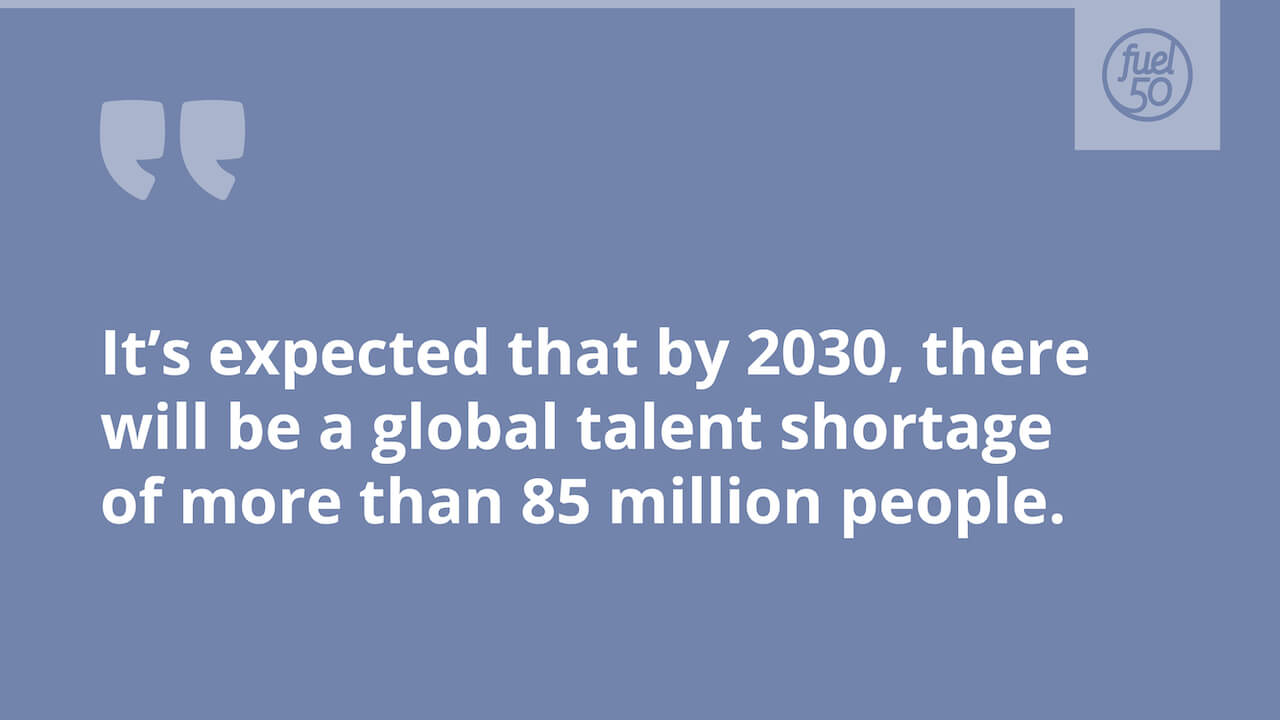The talent crisis has been a dark and looming cloud for years, with its effects starting to cause a full-blown storm in 2021 and beyond. It has led us to a 15-year low point in an ongoing talent shortage, and according to Korn Ferry, it’s only going to get worse. It’s expected that by 2030, there will be a global talent shortage of more than 85 million people.
Virtually every industry is taking the hit, with 10 million jobs still unfilled and idle. As much as we may try, it’s impossible to pin down one specific cause of the talent crisis, when in fact, there is a myriad of factors contributing to the shortage we are facing today, including:
- Older generations are leaving the workforce: There is a mass exodus of workers, primarily baby boomers who make up about one-third of the workforce that have reached retirement age and have left the workforce, or plan to in the next decade.
- The Great Resignation: In addition to baby boomers leaving the workforce, many others are either quitting work entirely, changing careers, or upgrading their jobs post-pandemic.
- The ongoing skills gap: As technology continues to advance at such a rapid rate, it has become increasingly difficult to find skilled talent to match evolving technologies.
- The evolving needs of employees: Workers’ expectations have changed post-pandemic. Remote working, flexibility, employee well-being, and career development are now non-negotiables for many employees. If their current employer doesn’t offer these benefits, they are eagerly searching for a company that does.
Organizations need to act now to mitigate the effects of the talent shortage and continue operating successfully. Leaders must re-evaluate how they are acquiring and retaining talent, and shift their focus from short-term to long-term talent strategies. Discover how organizations are navigating today’s talent crisis.

Develop a workforce fit for the future
According to Forbes, investing in current talent and preparing them for the future is key to overcoming the talent crisis. Organizations are beginning to implement intentional reskilling and upskilling programs aimed at closing their skills gaps and reducing their need to hire externally.
As employees begin to actively learn new skills, as well as build on existing skill sets, they become more adaptable, agile, and prepared for changes within your market. It builds their knowledge and improves their problem-solving capabilities, allowing you to leverage their skills to carry your organization through transformation and growth.
Korn Ferry states that organizations are implementing specialized training programs, coaching, and on-the-job experiences to effectively develop future-ready skills. Other companies such as NetApp and Fishawack Health are taking this initiative even further by implementing an AI talent marketplace that helps them gain better visibility into the skills and capabilities within their talent pool to identify skills gaps, reskill and upskill employees to fill those gaps, and ultimately increase internal mobility.
Instead of searching for external talent, leaders can optimize their current workforce by training them for new roles across the business and offering growth opportunities that benefit both employees and the organization as a whole.
Recruit with an open mind
Despite the talent crisis, many hiring managers are still hell-bent on employing candidates that fit job criteria to a tee. With over 10 million jobs still vacant in the labor market, and some still open for months, existing employees are having to work harder to cover the reduced manpower. This can negatively impact morale, employee well-being, and retention.
In order to fill these roles, organizations will need to adjust their hiring criteria and be open to recruiting less qualified candidates. According to Robert Walters, employing these kinds of candidates can have a wealth of benefits, including:
- Increased workforce diversity
- Fresh perspectives to problem-solving
- Increase in innovation
- Different skill sets that benefit multiple functions of an organization
That said, it’s imperative to look out for soft skills instead of solely focusing on education, qualifications, and hard skills to determine whether an individual is right for the job. Soft skills such as learning agility, leadership, teamwork, adaptability, and problem-solving are just as critical and enable employers to train these candidates to fill vacant roles despite their lower qualifications.
Major tech companies like Google and Apple are known to adjust their hiring criteria around education and qualifications to attract talent that can successfully drive innovation and creativity. Of course, it’s all about gauging whether the candidate has a base skill level that can be built on with the right training and development.

A strong Employer Brand Proposition goes a long way
With the war for talent at its peak, building a strong retention plan is imperative in keeping the skilled talent you already have. According to Fuel50 Research, the key to thriving in today’s current talent climate is the ability to leverage a strong Employer Brand Proposition (EBP). This allows you to distinguish yourself from competitors and promote your business as an employer of choice.
To enhance your EBP, you must formulate an attractive Employee Value Proposition (EVP), which includes the benefits and offerings you provide each employee in return for the skills, capabilities, and experiences they bring to an organization. This includes financial rewards such as salary and bonuses, as well as employee benefits such as paid time off, parental leave, flexibility, positive work environments, career growth, and ongoing development opportunities,
It’s important for leaders to truly understand what their people want and need to keep them happy, engaged, and motivated to stay. A stellar Employer Brand Proposition prioritizes employee needs and proves your organization is a great company to work for, enabling you to retain your best staff, and attract skilled workers within today’s saturated job market.
The effects of the talent shortage can’t be prevented, however, learning from organizations who are currently navigating through it can help ease the blow. Continuously strengthening your talent strategies by building a future-ready workforce, adjusting your recruiting practices to match the current environment, and having a solid employer brand all play a part in ensuring your organization is braced to take on the talent crisis now and in the future.






